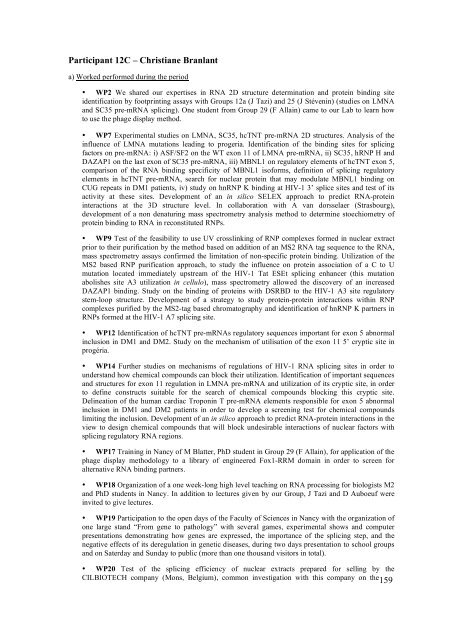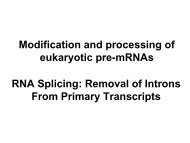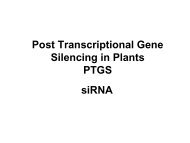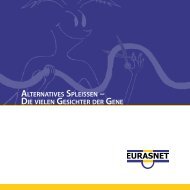You also want an ePaper? Increase the reach of your titles
YUMPU automatically turns print PDFs into web optimized ePapers that Google loves.
Participant 12C – Christiane Branlanta) Worked performed during the period• WP2 We shared our expertises in RNA 2D structure determination and protein binding siteidentification by footprinting assays with Groups 12a (J Tazi) and 25 (J Stévenin) (studies on LMNAand SC35 pre-mRNA splicing). One student from Group 29 (F Allain) came to our Lab to learn howto use the phage display method.• WP7 Experimental studies on LMNA, SC35, hcTNT pre-mRNA 2D structures. Analysis of theinfluence of LMNA mutations leading to progeria. Identification of the binding sites for splicingfactors on pre-mRNA: i) ASF/SF2 on the WT exon 11 of LMNA pre-mRNA, ii) SC35, hRNP H andDAZAP1 on the last exon of SC35 pre-mRNA, iii) MBNL1 on regulatory elements of hcTNT exon 5,comparison of the RNA binding specificity of MBNL1 isoforms, definition of splicing regulatoryelements in hcTNT pre-mRNA, search for nuclear protein that may modulate MBNL1 binding onCUG repeats in DM1 patients, iv) study on hnRNP K binding at HIV-1 3’ splice sites and test of itsactivity at these sites. Development of an in silico SELEX approach to predict RNA-proteininteractions at the 3D structure level. In collaboration with A van dorsselaer (Strasbourg),development of a non denaturing mass spectrometry analysis method to determine stoechiometry ofprotein binding to RNA in reconstituted RNPs.• WP9 Test of the feasibility to use UV crosslinking of RNP complexes formed in nuclear extractprior to their purification by the method based on addition of an MS2 RNA tag sequence to the RNA,mass spectrometry assays confirmed the limitation of non-specific protein binding. Utilization of theMS2 based RNP purification approach, to study the influence on protein association of a C to Umutation located immediately upstream of the HIV-1 Tat ESEt splicing enhancer (this mutationabolishes site A3 utilization in cellulo), mass spectrometry allowed the discovery of an increasedDAZAP1 binding. Study on the binding of proteins with DSRBD to the HIV-1 A3 site regulatorystem-loop structure. Development of a strategy to study protein-protein interactions within RNPcomplexes purified by the MS2-tag based chromatography and identification of hnRNP K partners inRNPs formed at the HIV-1 A7 splicing site.• WP12 Identification of hcTNT pre-mRNAs regulatory sequences important for exon 5 abnormalinclusion in DM1 and DM2. Study on the mechanism of utilisation of the exon 11 5’ cryptic site inprogéria.• WP14 Further studies on mechanisms of regulations of HIV-1 RNA splicing sites in order tounderstand how chemical compounds can block their utilization. Identification of important sequencesand structures for exon 11 regulation in LMNA pre-mRNA and utilization of its cryptic site, in orderto define constructs suitable for the search of chemical compounds blocking this cryptic site.Delineation of the human cardiac Troponin T pre-mRNA elements responsible for exon 5 abnormalinclusion in DM1 and DM2 patients in order to develop a screening test for chemical compoundslimiting the inclusion. Development of an in silico approach to predict RNA-protein interactions in theview to design chemical compounds that will block undesirable interactions of nuclear factors withsplicing regulatory RNA regions.• WP17 Training in Nancy of M Blatter, PhD student in Group 29 (F Allain), for application of thephage display methodology to a library of engineered Fox1-RRM domain in order to screen foralternative RNA binding partners.• WP18 Organization of a one week-long high level teaching on RNA processing for biologists M2and PhD students in Nancy. In addition to lectures given by our Group, J Tazi and D Auboeuf wereinvited to give lectures.• WP19 Participation to the open days of the Faculty of Sciences in Nancy with the organization ofone large stand “From gene to pathology” with several games, experimental shows and computerpresentations demonstrating how genes are expressed, the importance of the splicing step, and thenegative effects of its deregulation in genetic diseases, during two days presentation to school groupsand on Saterday and Sunday to public (more than one thousand visitors in total).• WP20 Test of the splicing efficiency of nuclear extracts prepared for selling by theCILBIOTECH company (Mons, Belgium), common investigation with this company on the159







